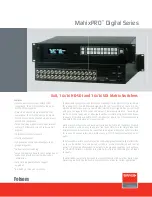
Troubleshooting
Unusual Network Activity
Spanning-Tree Protocol (STP) and Fast-Uplink
Problems
C a u t i o n
If you enable STP, it is recommended that you leave the remainder of the STP
parameter settings at their default values until you have had an opportunity
to evaluate STP performance in your network. Because incorrect STP settings
can adversely affect network performance, you should avoid making changes
without having a strong understanding of how STP operates. To learn the
details of STP operation, refer to the IEEE 802.1D standard.
Broadcast Storms Appearing in the Network.
This can occur when
there are physical loops (redundant links) in the topology.Where this exists,
you should enable STP on all bridging devices in the topology in order for the
loop to be detected.
STP Blocks a Link in a VLAN Even Though There Are No Redundant
Links in that VLAN.
In 802.1Q-compliant devices such as the switches cov
ered by this guide, STP blocks redundant physical links even if they are in
separate VLANs. A solution is to use only one, multiple-VLAN (tagged) link
between the devices. Also, if ports are available, you can improve the band
width in this situation by using a port trunk. See the chapter on VLANs in the
Advanced Traffic Management Guide
..
Fast-Uplink Troubleshooting.
Some of the problems that can result from
incorrect usage of Fast-Uplink STP include temporary loops and generation
of duplicate packets.
Problem sources can include:
■
Fast-Uplink is configured on a switch that is the STP root device.
■
Either the
Hello Time
or the
Max Age
setting (or both) is too long on one or
more switches. Return the
Hello Time
and Max Age settings to their default
values (2 seconds and 20 seconds, respectively, on a switch).
■
A “downlink” port is connected to a switch that is further away (in hop
count) from the root device than the switch port on which fast-uplink STP
is configured.
■
Two edge switches are directly linked to each other with a fast-uplink
(Mode =
Uplink
) connection.
■
Fast uplink is configured on both ends of a link.
■
A switch serving as a backup STP root switch has ports configured for
fast-uplink STP and has become the root device due to a failure in the
original root device.
C-14
Summary of Contents for ProCurve 2610-24
Page 1: ...Management and Configuration Guide 2610 2610 PWR ProCurve Switches R 11 XX www procurve com ...
Page 2: ......
Page 18: ...xvi ...
Page 24: ...Product Documentation xxii ...
Page 54: ...Using the Menu Interface Where To Go From Here 3 16 ...
Page 94: ...Using the Web Browser Interface Status Reporting Features 5 24 ...
Page 132: ...Switch Memory and Configuration Multiple Configuration Files 6 38 ...
Page 148: ...Interface Access and System Information System Information 7 16 ...
Page 192: ...Time Protocols SNTP Messages in the Event Log 9 24 ...
Page 256: ...Power Over Ethernet PoE Operation PoE Event Log Messages 11 18 ...
Page 280: ...Port Trunking Port Status and Configuration 12 24 ...
Page 362: ...File Transfers Copying Diagnostic Data to a Remote Host PC or Unix Workstation A 24 ...
Page 438: ...Troubleshooting Restoring a Flash Image C 48 ...
Page 446: ...MAC Address Management Viewing the MAC Addresses of Connected Devices D 8 ...
Page 450: ...Daylight Savings Time on ProCurve Switches Configuring Daylight Savings Time E 4 ...
Page 462: ...12 Index ...
Page 463: ......
















































